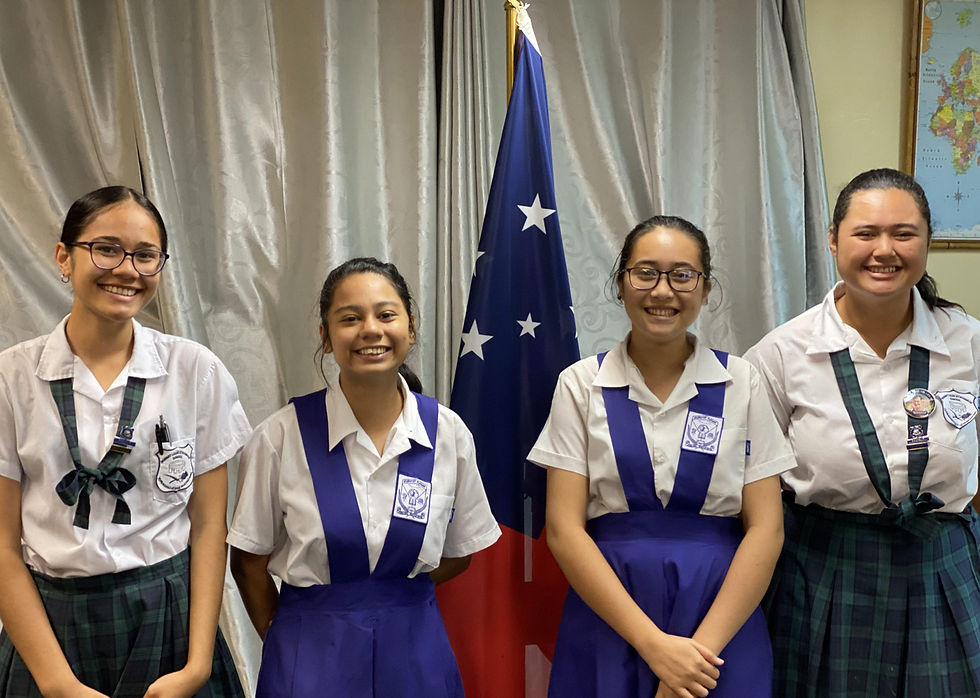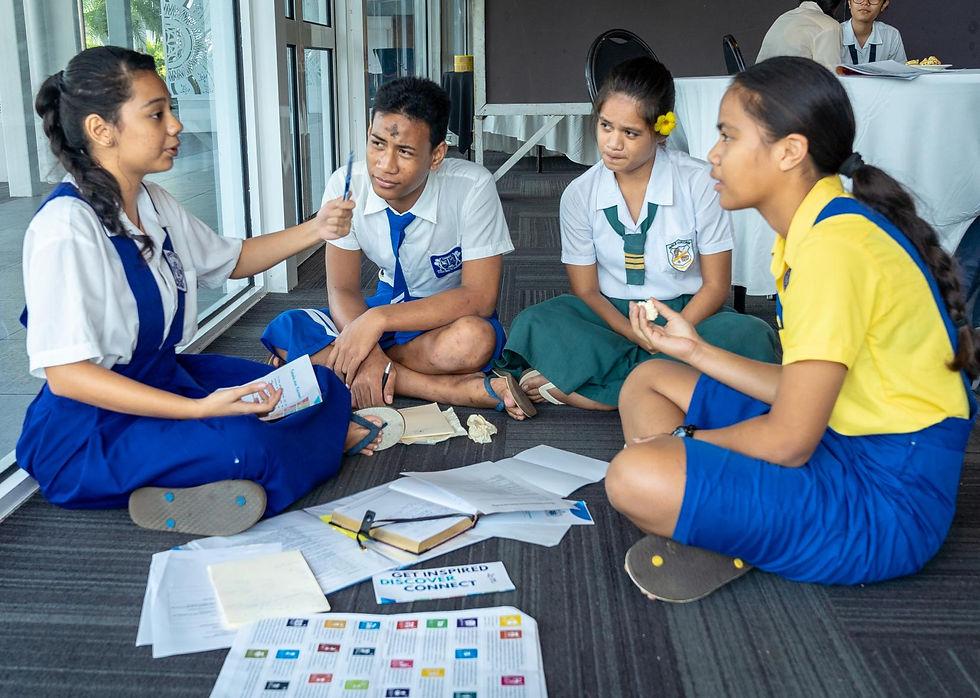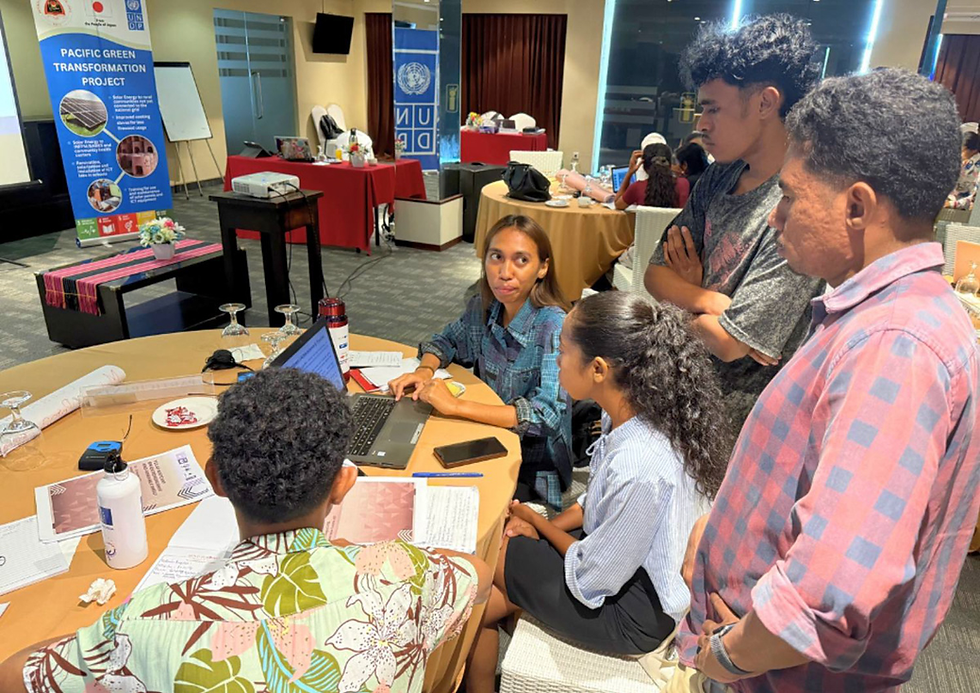Samoa’s Green Future Starts with YOUth
- Hasib Rafi
- Jun 19
- 6 min read
By Audrey Natasha Lee Hang, Early Childhood Education Teacher and Youth Advocate

When I think about the future of Samoa, I think about kids walking to school, breathing in clean air without the fumes of pollution. I also think about oceans that stay blue, coral reefs that remain pristine, and tropical rainforests that grow evergreen. Not many can imagine it, and soon maybe, not many will remember it. At the Local Conference of Youth (LCOY) Samoa and National Renewable Energy Day 2024, that future where Samoa stays beautiful and pristine felt tangible. It felt like we, the youth, were in the driver’s seat on the road to a sustainable Samoa.
LCOY Samoa took place on National Renewable Energy Day from 5-6 December 2024, following COP29. The conference was co-hosted by the Ministry of Natural Resources and Environment of Samoa, Global Shapers Apia Hub, and YOUNGO—the official children and youth constituency of the UNFCCC—with support from UNDP, YECAP, and partners. The participants included student leaders, young teachers, professionals, advocates, and community volunteers. We came from different communities and backgrounds, but we had one thing in common: a love for our islands and a determination to protect them.
I was a student representative from the National University when I attended, hopeful that Samoa would brief the youth about the COP29 outcomes—especially the global climate finance situation of $300 billion shortfall from approximately $1 trillion needed for adaptation and mitigation. While I didn’t expect Samoa to address the entire gap, I had hoped to hear how this global reality could impact our island nation and what strategies or opportunities lie ahead. Despite the drop in global climate financing, Samoa persists in its fight against climate change. On that day, the country made two clear commitments: one to green transportation, and another to youth participation in climate action.
Transportation is Samoa’s largest source of greenhouse gas emissions, accounting for up to 30 percent. At LCOY Samoa, the country proudly introduced its transition to green transport through electric vehicles (EVs). Although small islands like ours contribute little to global emissions, this was a powerful commitment to doing our part. After all, climate change demands collective responsibility.
The Climate Action Pathways for Island Transport (CAP-IT project) was met with excitement from the youth, especially during the session on Driving Towards a Greener Future led by Global Shapers Community. After the discussion on EVs, we contributed ideas to further Samoa’s green transition. A notable suggestion was to transition all public lighting like streetlights to solar power. More ambitious ideas proposed using district funds to distribute bicycles to families to reduce emissions even further and allocating solar-powered charging stations or EV car-sharing systems to rural communities, which are crucial to Samoa given our power shortage experience.
For many, green transition not only means technology co-existing with people and the environment, but it also improves our quality of life and safeguards nature. It’s about making transport safer for children and future generations, more accessible for the elderly and persons with disabilities, and less polluting for our health.
Samoa is blessed with abundant natural resources, and the sun, wind, water, and even geothermal energy, can all be harnessed as renewable clean energy sources. With the country aiming to generate 70% of its electricity from renewable sources by 2030, our country continues to take steadfast steps to a greener future.
Projects that encourage us to think about green transformation are important for youth. They show us that our government is taking concrete steps to mitigate and adapt to climate change and taking accountability for its emissions. They also build new pathways for us. My favourite story from this project is the National University using one of its electric vehicles, brought in through the efforts of the Government of Japan and UNDP, to train Technical and Vocational Education and Training (TVET) students. I’ve seen that EV with its hood popped open, as students examined it in class and learned about how they are powered by clean energy. And it was great to see the steps to securing a greener future and creating socioeconomic opportunities for young people at the same time.
The highlight of LCOY, however, was the proposal for a youth climate change group as it sparked passion among the attendees. Many of us have experienced tokenism fatigue by being invited for representation without any real decision-making power. But this project was different. It gave us an opportunity to shape it and lead it.
We called for an independent council of youth on climate change—the Samoa Youth Climate Change Council (SYCCC)— unattached to the government, to hold leaders accountable for their international climate commitments and ensure policies align with real needs. A council created with a bold mission: climate diplomacy and community engagement, rooted in solution-based activism. While we want representation at high-level climate meetings, we also believe that achieving small goals can lead to big impacts.
We envisioned what the Council should look like, how it could unite scattered youth climate efforts across the country, and how it could be an official platform for young people to shape national policies. Following its democratic government, the youth suggested that council members be elected from different districts so that everyone, from urban Apia to remote villages, has a voice.
Another youth from the Samoa Voyaging Society proposed localizing knowledge products, “Even making climate change topics available to Samoans in their own language, translating these hard technical words into words they understand, can make a huge difference.”
Since last year's LCOY, a lot has been happening. The youth statement is being finalized. The Council proposal is moving forward. And most importantly, I’ve seen more young people in my community talking about clean transport, renewable energy, and climate solutions, not just as the government’s job but as our responsibility too.
I’m currently an early childhood education teacher, and my work has always been in youth empowerment and at the policy level. I’ve been advocating for children’s rights and youth participation, with a strong focus on SDG 4: quality education for all. While my background is in environmental science, I’ve found a niche where education and climate change intersect. I truly believe climate change affects education, and that connection has shaped my journey. This is the beginning of both a personal and collective journey that could transform the future for Samoan youth.


I’m grateful to YECAP for that reason, for providing a safe and inclusive platform for Samoan youth to engage in climate activism alongside the government, without needing to conform to the government’s outlook. The Samoa Youth Climate Change Council is an opportunity for young people to have legitimate power in decision-making, while upholding the shared vision of a sustainable future for Samoa. This YECAP-supported initiative is a step closer to greater youth participation, both at the grassroots level and in high-level spaces. My hope is that Samoa continues its meaningful path toward climate accountability, alongside its youth, recognizing that young voices hold equal power.
UNDP, YECAP, the Ministry of Natural Resources and Environment, and all the partners who supported LCOY 2024 gave us a chance to gain knowledge, share our voices, and hone our skills, so that we can take climate action in our lives, our communities, and in national plans.
I hope the story from Samoa reminds young people across the Pacific that even on small islands, we have big capabilities to meaningfully engage in climate action. A clean and green future starts with us. To the youth of the Pacific: making a change is only as hard as you make it. You’d be surprised by how much support is out there for the ideas you want to bring to life in your community. There’s a reason youth are now front and centre, because the world needs our leadership.
- - - - -
The Pacific Green Transformation Project (Pacific GX), under UNDP’s Climate Promise and funded by the Government of Japan, supports Papua New Guinea, Samoa, Timor-Leste, and Vanuatu in transitioning to renewable energy and green growth. In collaboration with the Youth Empowerment in Climate Action Platform (YECAP), a regional youth-led platform supported by Sweden and Pacific GX, this initiative highlights how young people across the Pacific are leading the green transition. Pacific GX and YECAP are working together to equip youth with the skills, platforms, and resources they need to drive impactful climate action.
This article was originally published by UNDP Cook Islands, Niue, Samoa and Tokelau here.



Inspiring to see Samoa’s youth leading the charge toward a greener future. Empowerment and education go hand-in-hand just like how resume makers Malaysia for students empower professionals to build impactful career paths. Change starts with strong foundations.
Encouraging young people to save the environment is incredibly motivating! With the correct assistance, graduates may mould their careers in the same way that Samoa's youth leaders are influencing sustainability Graduate CV writing help guarantees that they enter the workforce with assurance. It all comes down to planning and purpose!